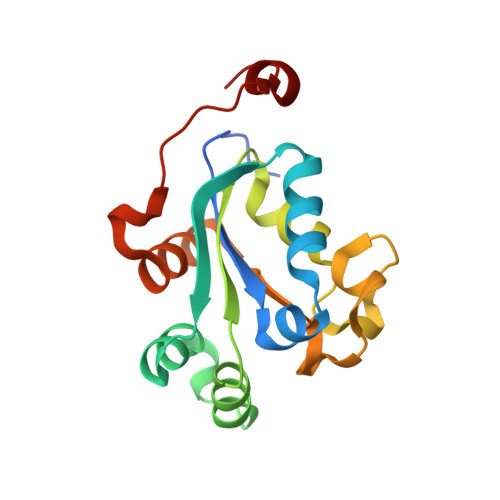Nucleoside selectivity of Aspergillus fumigatus nucleoside-diphosphate kinase.
Nguyen, S., Jovcevski, B., Pukala, T.L., Bruning, J.B.(2021) FEBS J 288: 2398-2417
- PubMed: 33089641
- DOI: https://doi.org/10.1111/febs.15607
- Primary Citation of Related Structures:
6XP4, 6XP7, 6XPS, 6XPT, 6XPU, 6XPV, 6XPW - PubMed Abstract:
Aspergillus fumigatus infections are rising at a disconcerting rate in tandem with antifungal resistance rates. Efforts to develop novel antifungals have been hindered by the limited knowledge of fundamental biological and structural mechanisms of A. fumigatus propagation. Biosynthesis of NTPs, the building blocks of DNA and RNA, is catalysed by NDK. An essential enzyme in A. fumigatus, NDK poses as an attractive target for novel antifungals. NDK exhibits broad substrate specificity across species, using both purines and pyrimidines, but the selectivity of such nucleosides in A. fumigatus NDK is unknown, impeding structure-guided inhibitor design. Structures of NDK in unbound- and NDP-bound states were solved, and NDK activity was assessed in the presence of various NTP substrates. We present the first instance of a unique substrate binding mode adopted by CDP and TDP specific to A. fumigatus NDK that illuminates the structural determinants of selectivity. Analysis of the oligomeric state reveals that A. fumigatus NDK adopts a hexameric assembly in both unbound- and NDP-bound states, contrary to previous reports suggesting it is tetrameric. Kinetic analysis revealed that ATP exhibited the greatest turnover rate (321 ± 33.0 s -1 ), specificity constant (626 ± 110.0 mm -1 ·s -1 ) and binding free energy change (-37.0 ± 3.5 kcal·mol -1 ). Comparatively, cytidine nucleosides displayed the slowest turnover rate (53.1 ± 3.7 s -1 ) and lowest specificity constant (40.2 ± 4.4 mm -1 ·s -1 ). We conclude that NDK exhibits nucleoside selectivity whereby adenine nucleosides are used preferentially compared to cytidine nucleosides, and these insights can be exploited to guide drug design. ENZYMES: Nucleoside-diphosphate kinase (EC 2.7.4.6). DATABASE: Structural data are available in the PDB database under the accession numbers: Unbound-NDK (6XP4), ADP-NDK (6XP7), GDP-NDK (6XPS), IDP-NDK (6XPU), UDP-NDK (6XPT), CDP-NDK (6XPW), TDP-NDK (6XPV).
- Institute of Photonics and Advanced Sensing (IPAS), School of Biological Sciences, The University of Adelaide, Australia.
Organizational Affiliation:
















